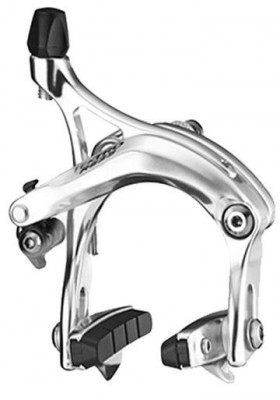Brake Dancing – The World of Longer-Reach Brakes
99% of road bike are sold with what we call “49mm reach brakes”. These are actually short reach brakes that limit tire and fender clearance. “Regular” (57mm) and “Long” (64mm) reach brakes disappeared from the market for many years, only reappearing about 10 years ago in small numbers. Though not yet favored by the big brands, these longer reach brakes offer excellent braking and dramatically increase a bikes functionality. Let’s start with a quick brake primer:
Short reach 49mm brakes became popular with the racing scene when Campagnolo introduced them in the 1960’s. With this design, the brake bolt is 49mm farther from the axle than the bottom of the brake pad slot. The slot on these brakes actually ranges from 39mm to 49mm. Even though this is what is normally used, it’s actually considered a “short reach” brake. It had a number of apparent advantages over the longer reach designs:

|
The brakes had a center pivot, which limited mechanical efficiency, particularly with longer reach brakes and lighter designs. |
During the 1980’s, racing bikes dominated the market. Demand plummeted for bikes with what were seen as clumsy add-ons like fenders and bigger tires. These touring bikes used center pull brakes, which work similar to cantilever brakes, with two pivots, but the center pull made it hard to assemble. Longer reach single pivot brakes were only used on cheaper bikes not designed for high performance.

49mm Dual Pivot Brake. |
During the 1990’s brake design underwent a revolution with the introduction of “dual pivot” designs, which have taken over the road caliper brake market. Shown below, the right pivot point is visible while the left is hidden under the more forward caliper. The braking power and quality of adjustment improved dramatically over the single pivot design. In the late 1990’s, Shimano reintroduced a 57mm reach brake version – first, at a low lever and then with an Ultegra-level design. In this case, the slot runs from 47-57mm. Even though it looks like a racing brake, the extra 8mm, is enough to fit 28C tires plus fenders. For people looking for a bike to ride in the rain, fenders come in handy. With the dramatic growth in commuting, fenders are a must to keep dirt off the rider as well as other cyclists on the road. Compare the short reach design above to the 57mm reach brake (at right). |

57mm Dual Pivot Brake. |
More recently, 64mm reach brakes with extra long slots (57-74mm) have appeared on the market, allowing 35C tires plus fenders to fit under a road caliper brake. The dual pivot design makes this possible.
These longer reach brakes open up many doors to cycling enthusiasts without adding weight to the frame. The longer reach means a shorter head tube and steerer to achieve the same fit as a short reach brake version. Yet the bike becomes much more versatile:
- Larger tires result in a more comfortable ride and increased wheel durability over smaller tires.
- Larger tires also increase the range of terrain a rider can enjoy, such as most gravel or many dirt roads.
- Fenders dramatically increase the range of appropriate weather for cycling.
- If you’re caught out in the rain, it’s a lot nicer to draft behind someone with fenders.
This has made fender-capable bikes much more popular, particularly in the northwest but also in any part of the country with good rainfall, which is pretty much anywhere from the Mississippi River east. Once you choose your brake, you must stick with it. It is possible to set a bridge height to allow both 49’s and 57’s, but the design wouldn’t achieve the desired extra tire/fender clearance.
While still not picked up by the big box bike makers, 57mm brake use has been growing among smaller builders looking to provide versatility without looking like a touring bike. It’s especially popular amoung the growing randonneuring crowd. It’s a great feature to add to your array of custom bike options.
Good article!
1 Comment �About 10 years ago Specialized used the 57mm reach levers on their Sequoia line of bikes, which were extremely popular, allowing 700×28 tires plus fenders, making the bikes much more versatile. Several years ago they dropped the line and have not replaced it with anything. All their bikes with sidepull brakes now are “short reach.”
I guess they think all their customers want to be “racers.”
I always advise customers to consider the versatility of more room under the brake arches when purchasing a new bike. Most always come back desiring fatter tires to smooth out the ride on our chip-and-seal roads. Many are disappointed when they are unsuccessful using any tire larger than 25C. Well, I say and smile, you could always convert your bike to 650B….then you’d have lots of room! So far, no takers!